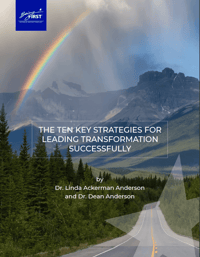Most organizations have many change initiatives occurring at once, in all parts of the organization, large and small – all making demands on people. Employees know they are being asked or pressured to change, but they often do not know why in terms that are meaningful to them. This makes it difficult for them to have a personal commitment to change. Leaders often interpret lack of employee commitment as resistance, but it is more likely stakeholders not understanding why the changes are essential to the success of the business, and importance of their role in it.
The pushback is usually not an employee issue, but a change leadership issue. Most people commit to what they believe in. And to believe in anything, people must see its relevance and meaning. Without perceiving relevance and meaning, there is no employee commitment. People must see themselves as contributing in ways they can relate to in support of the future of the business. Just because leaders say something is going to change doesn’t mean that stakeholders will understand it, do it, or sustain it. We know this all too well!
Perceiving Change Initiatives as Relevant
In general, relevance occurs when people see how something fits into the larger scheme of things. Most major change initiatives are launched to enable the organization to effectively implement its overarching business strategy in response to marketplace dynamics. When people can see how an initiative contributes to business (or department) success – how it responds to the marketplace, the company vision, and the execution of strategy to achieve the vision – they perceive the change as relevant and make a commitment to change. This big picture view gives the change initiative purpose, and raises the awareness of the workforce about its importance. Leaders are responsible for ensuring stakeholders have this larger understanding. They must communicate to employees – in the employees’ own terms – the relevance and meaning of each initiative as it is launched.
Traditionally, this level of “big picture” understanding is reserved for executives. In fact, this strategic understanding is the foundation of the executive role. Traditionally, management’s role was simply to execute change with blind faith. But in today’s competitive world, most organizations are in a constant flurry of change to keep pace with marketplace demands. The scope, scale, and pace of these change initiatives keep increasing. For stakeholders to be able to contribute fully, they too, must understand the relevance. They must see how it all fits together.
Perceiving Change Initiatives as Having Meaning
Meaning comes from how people see themselves in what is being asked of them. Is it important to them? Do they have the skills to succeed in it? Can they find where they personally fit in it? Do they understand the impact on them and what will be asked of them because of it? Will their role, responsibilities, or ways of working change because of it? How a person answers these questions impacts their emotional reaction to the change and their commitment to see it through. Meaning is personal and people need to know the personal impact of the change on them to find meaning in it and be willing to contribute to its success.
Are You Failing to Create Relevance and Meaning?
If you are seeing signs of resistance and lack of employee commitment or hearing from your workforce comments like “Why are we changing? Why is this more important than what I am doing now?” then you likely have a relevance and meaning issue. If people have been told about the change but are not making any changes, you are likely in the danger zone. If you are not getting the expected adoption rate to the changes, this may have its roots in this issue.
How Do You Create Relevance and Meaning to Ensure Employee Engagement?
Creating relevance and meaning is necessary to ensure stakeholder engagement and commitment.
To create relevance and meaning, try the following:
1. Stop any major change initiatives that do not directly support your business strategy.
Those that are not on the strategic radar screen will confuse your employees about the direction and priorities of the business. This is especially important when economic times are challenging and resources are scarce. Since managers often launch pet projects, these too must be checked for relevance to the business’ success.
2. Identify the highest leveraged changes based on your business strategy.
Describe those initiatives to your organization in ways that overtly link them to the realities of the external environment and your key business imperatives.
Map these connections so they are clear in terms your stakeholders can understand. They will better grasp your case for change based on visible marketplace dynamics and the desired outcomes of your overarching initiatives if they are described as logical extensions of your business strategy. This will go a long way toward building understanding in your workforce about the needs of your business, mobilizing action where it counts, and streamlining the number of initiatives happening.
3. Support people to dialogue with each other, and with leaders, about the most important question for them right now, “How will this impact me?”
Tell them what you know about the answer now, tell them what you don’t know, and invite them (where appropriate) to help figure it out.
Your responses may include impacts on people’s skills, knowledge, work practices, technology, reporting relationships, incentives, behaviors, and so on. Once they understand the impacts, make sure to assure them that your change strategy accounts for these impacts and they will receive adequate support to make the changes successfully.How Do You Sustain Relevance and Meaning Over Time?
Once relevance and meaning are in place in the minds and hearts of your stakeholders, you must maintain employee engagement and the commitment to change over time. If you start to hear comments like, “Is this change going to stick?”, it is a sign that the change may be losing relevance for people, or they may be wondering if the leaders will stay the course. Be prepared to periodically test employees’ level of understanding and commitment to the change outcomes. This is particularly important for your key stakeholder groups involved in making the changes, as well as those being impacted by them. People may understand the relevance and meaning when you first communicate with them, but their understanding will likely drift over time as daily work pressures take over. Proactively keep the strategic link in your people’s minds and make sure they continue to see how their efforts are making a difference to the success of the business until after you have achieved sustained business results.
Related eBook:
The Ten Key Strategies for Leading Transformation

Through 40 years of observing and supporting large-scale change and transformation in Fortune 500, government, global NGOs and public service organizations, we’ve identified these ten Best Practice strategies for leading transformation successfully.
Please complete the form to download your eBook:
Related Webinar:
How to Build Leadership Commitment to Transformation
In this on-demand workshop, we explore how to ask for, generate and nurture leadership commitment. The answer is not what you think, but it will radically improve your ability to get leaders committed. Developing this skill is one of the ten key strategies for ensuring success in any organization's transformation.


